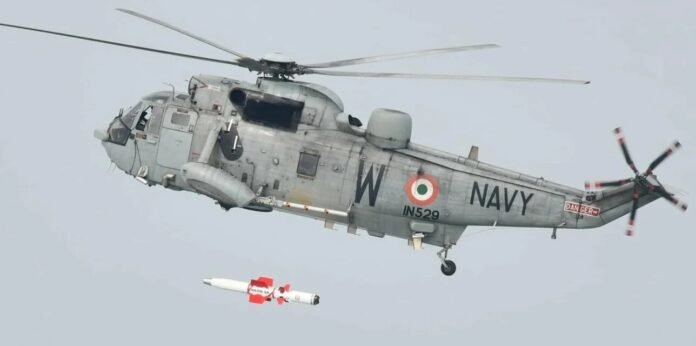
India has taken a significant step in strengthening its maritime security with the successful flight trials of the Naval Anti-Ship Missile Short Range (NASM-SR). Conducted jointly by the Defence Research and Development Organisation (DRDO) and the Indian Navy at the Integrated Test Range in Chandipur, Odisha, this achievement underscores India’s growing prowess in indigenous defence technology. The trials showcased the missile’s advanced capabilities, particularly its “Man-in-Loop” feature, allowing in-flight retargeting—an essential function for modern naval warfare.
Advanced Features of NASM-SR
The NASM-SR is a next-generation anti-ship missile equipped with state-of-the-art technology to ensure precise target engagement.
Key Features:
- Indigenous Imaging Infra-Red (IIR) Seeker: Enables high-precision targeting during the terminal phase.
- High-Bandwidth Two-Way Datalink: Transmits real-time images to the pilot, allowing for mid-flight target adjustments.
- Man-in-Loop Capability: Offers enhanced control by enabling retargeting in response to dynamic combat situations.
These sophisticated features make NASM-SR a formidable weapon, capable of delivering strategic superiority in maritime operations.
Launch and Target Engagement Capabilities
The recent trials saw NASM-SR launched from an Indian Naval Seaking helicopter. The missile initially locked onto a large target within a pre-designated search area. However, in its terminal phase, the pilot successfully redirected it to a smaller, concealed target. This ability to switch targets mid-flight, while maintaining high accuracy, highlights its advanced sea-skimming mode—a crucial tactic for evading enemy radar detection and countermeasures.
Cutting-Edge Guidance and Navigation Systems
The NASM-SR missile is designed with multiple layers of navigation and guidance systems, ensuring precision and efficiency throughout its flight path.
Navigation Components:
- Fiber Optic Gyroscope-Based Inertial Navigation System (INS): Ensures stability and accuracy in mid-course guidance.
- Radio Altimeter: Aids in altitude control for better maneuverability.
- Integrated Avionics Module: Supports real-time data processing for smooth operation.
- Electro-Mechanical Actuators: Provide precise control and steering.
- Solid Propulsion System: Features an in-line ejectable booster and a long-burn sustainer, enhancing speed and range.
These technological advancements make NASM-SR a highly reliable and versatile weapon, ideal for neutralizing threats in complex naval environments.
Indigenous Development and Production
The NASM-SR is a testament to India’s commitment to self-reliance in defence manufacturing. It is being developed by multiple DRDO laboratories, including:
- Research Centre Imarat (RCI)
- Defence Research and Development Laboratory (DRDL)
Moreover, the missile’s production involves collaborations with micro, medium, and small enterprises (MSMEs) and startups, reinforcing India’s Atmanirbhar Bharat (Self-Reliant India) initiative. This partnership not only accelerates technological innovation but also strengthens India’s defence industrial base.
Strategic Importance and Future Implications
The successful trial of NASM-SR marks a crucial advancement in India’s naval warfare capabilities. Defence Minister Rajnath Singh hailed the missile’s unique “Man-in-Loop” feature, emphasizing its potential to enhance operational effectiveness through real-time mission adaptability.
Why NASM-SR Matters for India’s Defence Strategy?
- Enhances India’s maritime strike capabilities against emerging threats.
- Strengthens the Navy’s ability to counter enemy warships and hostile assets.
- Reduces dependency on foreign weapon systems, promoting indigenous defence solutions.
With continued testing and refinement, NASM-SR is set to become a key asset in India’s naval arsenal, significantly reinforcing its maritime deterrence and security posture in the Indo-Pacific region.
Summing Up
The successful flight trials of NASM-SR represent a major milestone in India’s defence innovation and strategic preparedness. As the nation moves toward self-sufficiency in advanced weaponry, this indigenous missile system stands as a symbol of technological excellence, ready to safeguard India’s maritime interests in an increasingly complex global security landscape.

